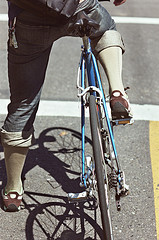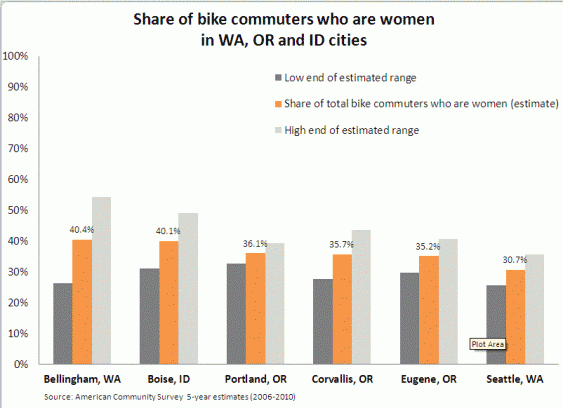Why don’t women bike to work more often? You hear many theories: we’re less willing to ride in traffic, we can’t arrive at a showerless office all sweaty, we never bothered to learn how to fix a flat, our schedules are over-extended, we work longer hours to make the same money as men, those of us with kids spend twice as much time on average caring for them, and many of us squeeze in shopping and errands on the way to and from work.
There’s no single satisfying answer, although convenience is a recurring theme. Sometimes,though, the reason can be as stupid as a garage door. When I evaluated all the things in my life that keep me from hopping on my bike more often, that’s what it boiled down to. I used to keep my bike in the back yard, but after I bought a trailer to haul around our 3-year-old, it was too cumbersome to hoist all of that up the steep stairs to our house and then squeeze through bushes and trees to get to our covered back deck. The other option was our garage, which has an old wooden door that’s falling apart. After some reflection, I realized that I hate to open it because every time I do I’m afraid that I’m going to do irreparable damage and then I’ll have to pay a lot of money to replace it. So there my bike sits, held hostage by a lack of handiness and disposable income.
According to new 5-year estimates from the commute section of the American Community Survey (2006-2010), I’m not alone. Even among Northwest cities with significant numbers of female bike commuters, the percentage of women who primarily biked to work in the week before they were surveyed ranged from a low estimate of 1.8 percent for Seattle to 7 percent in Corvallis, Oregon.

For a larger version of this chart, click here.
Keep in mind, these estimates don’t offer an accurate picture of overall bicycle use because they don’t capture trips to the grocery store or to a friend’s house or any other non-work-related trips. They’re based on the nationwide ACS survey that asks people to report how they traveled to work most often in the previous week. Because of the sample sizes, the estimates also have sizeable margins of error (represented by the gray bars in the chart above) that made the results meaningless for any city that didn’t have a fairly substantial number of women bike commuters. Even estimates from Spokane, Olympia or Salem weren’t accurate enough to be included. In general, the larger the city, the more reliable the estimates are.
Still, the results are pretty interesting.
First, look at the huge disparity among the different cities. What prompts 1 out of every 14 women commuters in Corvallis to hop on a bike vs. 1 out of every 55 in Seattle? Obviously, the city’s size makes a huge difference, both in terms of the distance one has to travel to work and the amount of traffic you have to contend with. And when women were asked in a 2011 survey what would prompt them to start or increase their cycling, the number #2 answer (behind convenience, which won by a landslide) was better bike infrastructure. That included better engineered bike routes, winter weather plowing and maintenance, dedicated bike lanes, places to shower afterwards, and accessible and secure parking near their workplaces and schools. They also cited the need for bike shops and mechanics that cater to women, or at the very least that don’t give people like me the I-can’t-believe-I-actually-have-to-wait-on-you attitude that one not-infrequently encounters in Seattle bike shops. Another survey focusing specifically on low-income women in San Francisco raised access to a free or low-cost bicycle, the distance they have to travel to work, and the ease of using cars as significant barriers.
When you look at what percentage of a city’s total bike commuters are women, Seattle also brings up the rear. According to these estimates, only 30.7 percent of the city’s bike commuters were women, meaning that men outnumber them on the road more than 2 to 1. Portland, Corvallis and Eugene had roughly 35 percent women, while Boise and Bellingham came out on top with 40 percent (bearing in mind that the estimates for the smaller cities have a fair amount of wiggle room).
For a larger version of this chart, click here.
If women are an “indicator species” that demonstrate how bike-friendly a city truly is, then clearly some Northwest cities have more work to do. But all the bike infrastructure in the world won’t change the persistent inequities between men and women–in terms of income, division of labor within a family and the responsibilities for childcare–that can make regular bicycling more challenging for women. While you can often find time you never knew you had for things that you decide to prioritize, I’d happily pay to get my garage door fixed if someone could just make an extra hour magically appear every day.




Comments are closed.